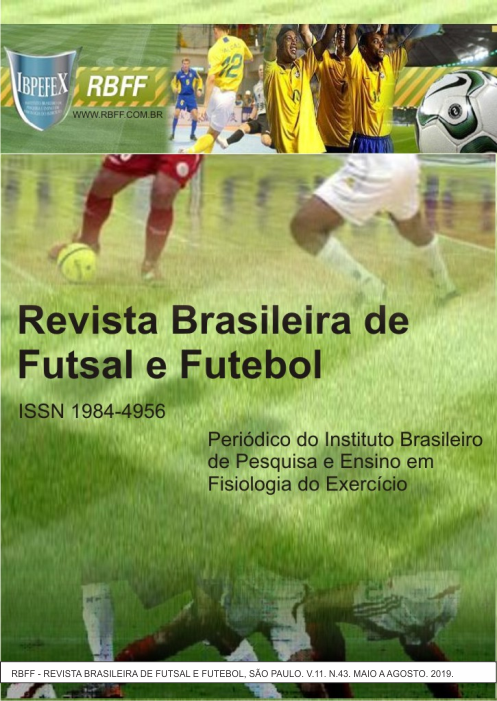Physical fitness related to performance in teenage futsal practitioners
Abstract
Introduction: Adequate levels of physical fitness can bring better results to athletes, avoiding injuries and increasing their performance. Objective: To analyze performance-related physical fitness in sub-17 adolescents, as well as to investigate their relationship with training frequency. Methods: A cross - sectional study was carried out with 30 male adolescents practicing futsal born in (2001 and 2002), from a school in the city of São Gonçalo do Amarante, Ceará. Information on body mass index, weekly training frequency and performance-related physical fitness were collected according to the Brazilian Sport Project (PROESP-BR). The tests performed were: Upper limb force (FMS) - 2kg medicineball pitch; Lower limb strength (IMF) - horizontal jump; Speed (running 20 meters); Agility (square test - 4 meters) and Cardiorespiratory Fitness Test (9 minute run / walk). Results: Adolescents presented adequate nutritional status with an overall mean of (21.33 ± 2.92). Adolescents who trained four to five times a week had a better cardiorespiratory test result (1848.7 ± 76.0) than those who trained two and three times (1414.5 ± 359.5 and 1753.2 ± 207, respectively, 5, p = 0.002). Higher prevalence of adolescents was classified as excellent only in the velocity test (30.0%). Conclusion: It is concluded that a higher frequency of weekly training is associated with an improvement in the performance of cardiorespiratory fitness. It is suggested that studies on physical fitness have their results presented to teachers and / or coaches of sports modalities as a tool to aid in the preparation of their training.
References
-Avelar, A.; Santos, K. M. D.; Cyrino, E. S.; Carvalho, F. O.; Dias, R. M. R.; Altimari, L. R.; Gobbo, L. A. Perfil antropométrico e de desempenho motor de atletas paranaenses de futsal de elite. Revista Brasileira de Cineantropometria e Desempenho Humano. Vol. 10. Num. 1. 2008. p. 76-80.
-Bompa, P.O. Treinamento total para jovens campeões. Tradução de Cássia Maria Nasser. Revista Cientifica de Aylton J. Figueira Jr. Barueri: Manole, 2002.
-Conde, W.L; Monteiro, C.A. Body mass index cutoff points for evaluation of nutritional status in Brazilian children and adolescents. Jornal de Pediatria. Vol. 82. Num. 4. 2006. p. 266-272.
-Diesporte. Diagnóstico Nacional do Esporte -Caderno I. Ministério do Esporte. 2015
-Fiorante, F.B.; Pellegrinotti, Í.L. Efeitos de um programa periodizado de futsal na aptidão física de estudantes femininas de 13 e 14 anos de idade. Revista Brasileira de Futsal e Futebol. Vol. 10. Num. 38. 2018. p. 285-293. Disponível em: <http://www.rbff.com.br/index.php/rbff/article/view/589>
-Garlipp, D.C. Dimorfismo sexual e estabilidade no crescimento somático e em componentes da aptidão física: análise longitudinal em crianças e adolescentes. Dissertação de Mestrado em Ciências do Movimento Humano. Escola Superior de Educação Física. Universidade Federal do Rio Grande do Sul. 2006.
-Guedes, D.P. Programas de controle do peso corporal: Atividade Física e Nutrição. Revista Mineira de Educação Física. Vol. 101. Núm. 1. 2002. p. 64-90.
-Kraemer, W.J.; Ratamess, N.A.; Flanagan, S.D.; Shurley, J.P.; Todd, J.S.; Todd, T. C. Understanding the science of resistance training: An evolutionary perspective. Sports Medicine. Vol. 47. Num. 12. 2017. p. 2415-2435.
-Mcardle, W.D.; Katch, F.I.; Katch, V.L. Fisiologia do Exercício: Energia, Nutrição e Desempenho Humano. Tradução de Giuseppe Taranto. 3ª edição. Guanabara Koogan. p. 510. 1991.
-Molinuevo, J.S.; Ortega, A.M. Perfil morfofuncional de un equipo de futbol-sala. In: Anais do I Congresso internacional sobre ciencia y tecnica del fútbol.Madrid. 1989. p. 217-224.
-Nunes, R.F.H.; Danieli, A.V.; Flores, L.J.F.; Coelho, T.M.; Cetolin, T.; Carminatti, L.J.; Da Silva, J. F. Potência aeróbia em atletas de futebol e futsal de diferentes níveis competitivos. Revista Brasileira de Ciência e Movimento. Vol. 25. Num. 4. 2017. p. 5-14.
-Projeto Esporte Brasil. PROESP-BR. Universidade Federal do Rio Grande do Sul. 2016. Disponível em: <https://www.ufrgs.br/proesp/arquivos/manual-proesp-br-2016.pdf>. Acesso em: 20/06/2018.
-Santos, A.F.; Giarolla, R.A.; Figueira JR., A.J. Perfil de aptidão física de jogadores de futebol de salão. In: Anais da II Bienal de ciências do esporte. São Paulo. p. 21. 1991.
-Silva, V.C.; Teixeira, F.A.A.; Alves, F.R.; de Souza, E.A. Análise de aptidão física de adolescentes praticantes de Futsal. Revista Brasileira de Futsal e Futebol. Vol. 9. Num. 34. 2017. p. 250-258. Disponível em: <http://www.rbff.com.br/index.php/rbff/article/view/496>
-Silva, J.F.; Detanico, D.; Floriano, L.T.; Dittrich, N.; Nascimento, P.C.; Santos, S.G.; Guglielmo, L.G.A. Níveis de potência muscular em atletas de futebol e futsal em diferentes categorias e posições. Motricidade. Vol. 8. Num. 1. 2012. p. 14-22.
-Venâncio, P. E. M.; de Souza Silva, J. P.; Ribeiro, H. L.; Soares, V.; Santana, F.; Tolentino, G. P. Aptidão física em adolescentes praticantes de Futebol. Revista Brasileira de Futsal e Futebol. Vol. 10. Num. 36. 2018. p. 41-48.Disponível em: <http://www.rbff.com.br/index.php/rbff/article/view/536>
-World Health Organization. Physical status: the use and interpretation of anthropometry. Geneva: WHO; 1995. (Technical Report Series, 854).
Authors who publish in this journal agree to the following terms:
- Authors retain the copyright and grant the journal the right of first publication, with work simultaneously licensed under the Creative Commons Attribution License BY-NC which allows the sharing of the work with acknowledgment of the authorship of the work and initial publication in this journal.
- Authors are authorized to enter into additional contracts separately for non-exclusive distribution of the version of the work published in this journal (eg, publishing in institutional repository or book chapter), with acknowledgment of authorship and initial publication in this journal.
- Authors are allowed and encouraged to post and distribute their work online (eg, in institutional repositories or on their personal page) at any point before or during the editorial process, as this can bring about productive change as well as increase impact and impact. citation of published work (See The Effect of Free Access).





